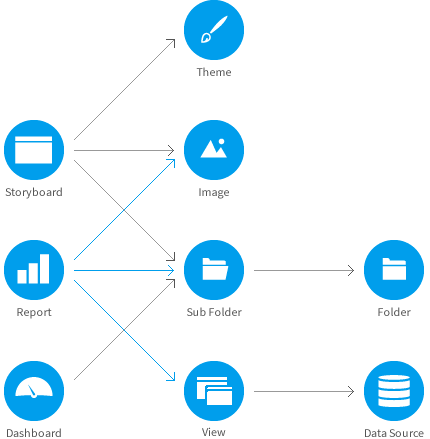Page History
...
| Styleclass | ||
|---|---|---|
| ||
Yellowfin's export and import modules let you migrate your content between multiple Yellowfin instances, saving you time and effort from creating the same data in each environment individually. Unlike the previous versions, Yellowfin 7.3+ tracks and compares each file you transfer through its universally unique identifiers (or UUID), to restrict multiple copies of the same reports and data from existing in an environment. Therefore, even if the same files have different names, Yellowfin will be able to detect that they a are match and warn you from copying them, saving you from an overload of redundant data from existing in your system.
An important concept to know about here is content dependencies, which we will learn about next provides you with the capacity to export all your content definitions including the related entities from one instance of Yellowfin (e.g. QA) and import these into a separate instance (e.g. Production).Note: When exporting definitions from Yellowfin there are certain limitations. You cannot export security settings that relate to individual users, only group or roles. These will have to be reset when importing them into the new instance of Yellowfin. Source filter information will be exported but only if it is a scheduled SQL query. Manual records and data file records will not be exported. This is because it's assumed that users will differ between instances, but groups and other structures will be the same.
Content Dependencies
When exporting content, it's important to not only select the items you wish to export, but also all other items the main content may depend on to work.
Yellowfin's content dependency structure is illustrated to the right.
For example, if you are exporting a Report you will need to either:
- include all images it uses, the category and sub category it's stored in, and the view and source connection it's based on, or
- ensure all the items above are already available in the instance you plan on importing the item into
Database Independence
If you are using the export and import functions to migrate Yellowfin across platforms then you will have to be mindful of any hard coded SQL. Examples of this may be:
- Created Virtual Tables within the View
- Freehand SQL Calculated Fields in the View
- Freehand SQL Reports
- BIRT or Jasper reports with platform specific SQL
Yellowfin cannot test for these SQL anomalies and you should test your export and import processes across platforms in your test environment prior to migrating into production.
Dependencies are any content that the main or primary content is dependent on to function properly in a Yellowfin environment. For example, a report is dependent on a view, and the view on a data source. Therefore, for the report to work in a Yellowfin instance, it relies on that view and data source to be present in that instance.
Yellowfin's content dependency structure is illustrated below.
Export Process
| Styleclass | ||
|---|---|---|
| ||
...
| horizontalrule |
|---|
| Styleclass | ||
|---|---|---|
| ||
Yellowfin’s export and import modules let you to migrate your content between multiple Yellowfin instances, saving you time and effort from creating the same data in each environment individually.
Unlike the previous versions, Yellowfin 7.3+ tracks and compares each file you transfer through its universally unique identifiers (or UUID), to restrict multiple copies of the same reports and data from existing in an environment. Therefore, even if the same files have different names, Yellowfin will be able to detect that they’re a match and warn you from copying them, saving you from an overload of redundant data from existing in your system.
...
